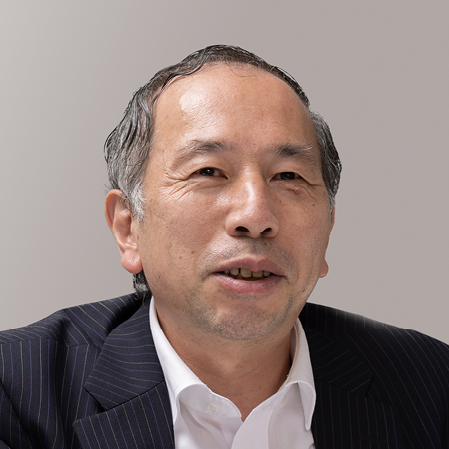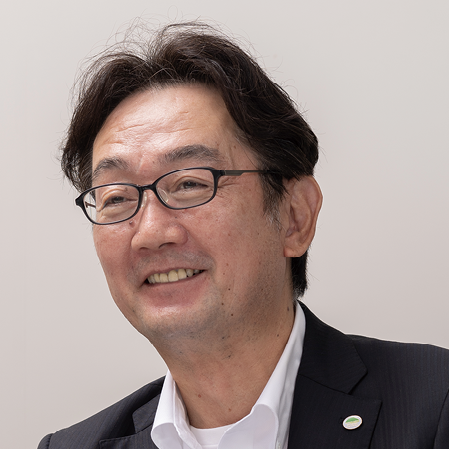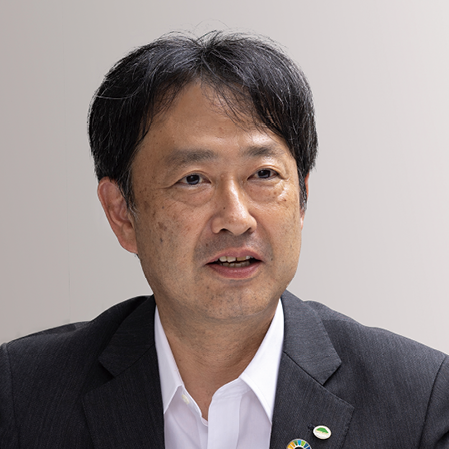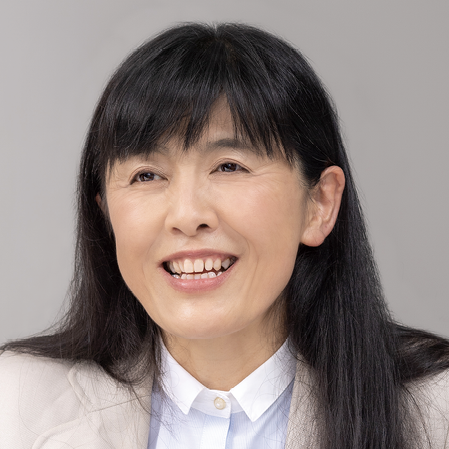COVER STORY:CONCEPT
How CASE is Transforming the Future of Motoring
Industry is undergoing an energy transition with an acceleration in electrification as countries and regions around the world take up the challenge of achieving carbon neutrality by 2050 to address worsening climate change. This is bringing major changes to the field of mobility, especially the automotive sector, and is prompting an ongoing shift toward “connected, autonomous, shared & services, and electric” (CASE) practices as well as wider adoption of non-gasoline vehicles. Having played a key role in both people’s way of life and in industrial progress, how can mobility now meet the new challenge of building a sustainable society? What will mobility look like in the future and how will it figure in society? What technologies will be needed to bring this about? Hitachi Review has invited Professor Yoshihiro Suda from the University of Tokyo, a leader in research into next-generation mobility, to share his views with key people from the mobility sector at Hitachi.
 Yoshihiro Suda,Ph.D.
Yoshihiro Suda,Ph.D.
Director, Mobility Innovation Collaborative Research Organization and Professor, Advanced Mobility Research Center, Institute of Industrial Science, the University of Tokyo
Graduated from the Department of Mechanical Engineering, Faculty of Engineering at the University of Tokyo in 1982 and went on to complete masters and doctoral degrees at the Graduate School of Engineering (Doctor of Engineering). Following positions as Associate Professor at the Hosei University Department of Mechanical Engineering, Faculty of Engineering and Visiting Associate Professor at Queen's University in Canada, he was appointed Professor at the Institute of Industrial Science, the University of Tokyo in 2000. He has been Director of the institute’s Chiba Experiment Stations since 2007 and of the Advanced Mobility Research Center (ITS Center) since 2010. He was appointed Director of the Mobility Innovation Collaborative Research Organization at the University of Tokyo in 2018. His specialties are in automotive control engineering and intelligent transportation systems (ITSs). He has served as a director or councilor on a number of academic societies in Japan and elsewhere, has chaired international conferences, and has sat on government committees including for the Ministry of Land, Infrastructure, Transport and Tourism.
 Toru Kamioke
Toru Kamioke
Representative Director, Executive Vice President, and Head of Powertrain & Safety Systems Business Division, Hitachi Astemo, Ltd.
Joined Hitachi, Ltd. in 1984 and transferred to Hitachi Automotive Products (America) Inc. in 1999. He was appointed to the Sales Division of the Automotive Systems Group in 2004, became deputy head of sales at Hitachi Automotive Systems, Ltd. in 2009, and was made Director of Hitachi Automotive Systems, Ltd. and President of Hitachi Automotive Systems Americas Inc. in 2013. He became an Executive Officer and General Manager of Sales in 2016, Vice President in 2018, and Executive Vice President and head of the Powertrain & Safety Systems Business Division in 2019. He was appointed to his current position in 2021.
WatanabeIn 2020, the Japanese government announced its goal of achieving carbon neutrality by 2050 in order to minimize global-scale climate change. Meanwhile, there is growing momentum behind work toward the Sustainable Development Goals (SDGs) and rising interest in what form the vehicles of the future should take if they are to play their part in achieving sustainable societies. Technological innovation is advancing across a range of fronts, accompanied by the emergence of those new trends embodied in the term “CASE.” Professor Suda, having engaged in research into the next generation of mobility, could you please give us your take on these developments.
SudaWhile the term “CASE” came to prominence a few years ago, it is the electrification aspect that is seeing a rapid growth in interest as carbon neutrality has become established as a key goal for the future. As for the other aspects of “connected,” “autonomous,” and “shared & services,” we can expect an acceleration in the trend toward mobility-as-a-service (MaaS), whereby vehicles are made available in the form of services rather than as products.
In tandem with carbon neutrality, safety is another key factor that is gaining in importance. Traffic deaths in Japan have been on a steadily falling trend as a result of vehicle performance improvements and law enforcement initiatives, dropping below 3,000 in 2020. I currently chair the Technology and Safety Working Group at the Council for Transport Policy of the Road Transport Bureau (Ministry of Land, Infrastructure, Transport and Tourism) where we are seeking to further accelerate this trend by setting a target of zero traffic deaths caused by cars (new vehicles), which is to be achieved by equipping them with accident prevention mechanisms. While this is a very challenging goal, I believe this ambitious target is needed if we are to address the issue seriously from both a technological and regulatory perspective.
Achieving freely flowing traffic with reduced accidents and congestion also contributes to the goal of carbon neutrality by ensuring that less energy is wasted. In the future, it will be vital to consider energy efficiency across the entire field of transportation rather than just vehicles in isolation.
It is possible that demand for mobility and quality expectations will change considerably in the post-COVID world. While this may present as a headwind for the automotive industry, I see the industry as having a promising future if it can successfully ride the wave of change.
KamiokeThose of us at the front line of business are reminded of these changing times on a daily basis. Numerous countries and automotive manufacturers have announced targets for the introduction of electric vehicles (EVs) over the last half year or so and this has been accompanied by a surge in the number of inquiries about EV-related parts. There is rising interest in the safety technologies you talked about as helping to reduce traffic accidents as well as in products and solutions for things like improving ride comfort and ensuring travel flexibility.
AidaReducing the load on the environment and achieving zero traffic accidents are both long-term goals for the automotive industry, and the way that CASE opens up prospects for achieving these goals represents a major step forward. Electrification as a means of achieving carbon neutrality and advances in driving safety assistance systems are accelerating, with technological innovation in areas like batteries, power electronics, and control playing a major role alongside policy measures. While rising investment in these areas is intensifying development competition, we at Hitachi Astemo aim to draw on the comprehensive capabilities of the wider Hitachi Group to lead this innovation.
WatanabeHow does Hitachi’s Research & Development Group see these trends in mobility?
MoritaHitachi has been pursuing its Social Innovation Business since 2009. While this business is about using digital technology to bring innovation to social infrastructure and resolve the challenges facing both customers and wider society, it seems that these last few years have brought forth a range of new challenges and rising expectations for solutions. In the case of carbon neutrality in particular, as of April 2021, 125 countries and one region had announced their intention to achieve this by 2050. Doing so will require considerable innovation. Accordingly, alongside a forecasting mentality that focuses on strengthening existing activities, we are also putting in place long-term strategies for research and development (R&D) that are based on backcasting from the sort of world we want to have in 2050.
We anticipate an automotive industry that is primarily based on EVs, with greater use also of hydrogen through technologies such as fuel cells in large commercial vehicles. Along with changes in the nature of mobility driven by advances in autonomous driving, we can also expect an increasing number of new entrants from outside the industry, not least of which will be information technology companies. In this environment, our aim is to take the lead in open innovation and to facilitate the development of the next generation of mobility that will incorporate digital technologies.
 Keiichi Aida
Keiichi Aida
Board Director, Executive Vice President, CTO, CISO, and Head of Technology Development Division, Hitachi Astemo, Ltd.
Joined Honda Motor Co., Ltd. in 1986. He became a director of Honda R&D Co., Ltd. in 2015 with responsibility for integrated control development (autonomous driving and connected platform development), an executive director in 2018 with responsibility for power train strategy, and was appointed President and CEO of Keihin Corporation in 2019. He was appointed to his current position in 2021.
WatanabeGiven the rising importance of things like safety, security, and the environment, the automotive industry is clearly going through a time of major change. Professor Suda, can you give us your views on what we can expect in the future?
SudaWhile I do not know whether I will live to see the achievement of carbon neutrality in 2050, with regards to safety at least, I want to create a society in which everyone is free to travel where and when they want, and to do so in a safe and stress-free way without imposing a heavy load on the environment. However, even if it seems that achieving this will eliminate the need for public transportation, public transportation also has a vital role to play as a place where people learn the rules of society. Should everyone in the future have easy access to personal means of transportation, it may be that this will in turn prompt calls for something like public mobility to provide places where people can learn how to behave in public.
KamiokeProviding safe and stress-free ways for people to travel wherever they want will enhance sustainability across all of society, also helping to free up mobility as you talked about earlier. This is an issue that the entire automotive industry needs to address, with our aim as a supplier being to contribute through the development and supply of the required technologies, such as ways of enabling vehicles to communicate externally and to determine what is happening around them.
Along with supplying products that facilitate carbon neutrality through electrification, another issue applicable to the more immediate future is that we also need to decarbonize the manufacturing process and the wider product lifecycle. At Hitachi Investor Day 2021, we were quizzed by a number of investors about our specific actions for achieving carbon neutrality. Recognizing that we now live at a time when carbon neutrality influences corporate value and investment decisions, we intend to take action in response to this trend, having set targets for 2030 for both Hitachi’s plants and products, namely zero carbon dioxide (CO2) emissions from the production process and a 50% reduction in emissions during product use.
AidaWhile its objective of minimizing climate change makes carbon neutrality a common goal for all the world’s people, and also a basis for policy at the national government level, the reality at present is that it is not a major consideration for the end users who actually purchase vehicles. In other words, achieving a widespread uptake of EVs will likely be difficult unless the vehicles available to those end users are seen as convenient and good value. As a supplier, we intend to offer products that enhance the value of EVs. Moreover, what I also believe will be important will be to deliver value through interoperation with energy infrastructure in the form of vehicle-to-home (V2H) and vehicle-to-grid (V2G) capabilities that, respectively, enable EVs to supply power to homes and to act as buffers that stabilize electricity grid operation.
Likewise with autonomous driving and driver assistance systems. In addition to preventing traffic accidents, higher levels of autonomous driving will enable these systems to take over from the driver and free them up to engage in other tasks. This is why we are working hard on the technologies for level 3 autonomous driving, also looking ahead to level 4.
 Ayumu Morita,Ph.D.
Ayumu Morita,Ph.D.
General Manager, Center for Technology Innovation, Research & Development Group, Hitachi, Ltd.
Joined Hitachi, Ltd. after graduating with a doctorate in electrical engineering from the Graduate School of Engineering at the University of Tokyo in 1995. He worked on the research and development of electrical distribution equipment and systems at the Power & Industrial Systems R&D Laboratory, Energy and Environmental Systems Laboratory, and Hitachi Research Laboratory. As General Manager of the Center for Technology Innovation, Research & Development Group, he has led research and development in the social infrastructure sector since 2018. He is a Doctor of Engineering and a member of the Institute of Electrical Engineers of Japan (IEEJ), IEE, and the International Council on Large Electric Systems (CIGRE).
 Keiko Watanabe
Keiko Watanabe
Moderator
Senior Director, Technical Planning Department, Technology Development Functional Division, Hitachi Astemo, Ltd.
WatanabeHow to optimize freight is one of the issues that arises when considering the future of mobility.
SudaYes. While we tend to focus on the movement of people when we talk about mobility, the movement of goods is likewise important. Even during the pandemic, freight levels have remained the same or higher, and improving the efficiency of this transportation is essential for achieving sustainable mobility. The flow of freight involves both arteries (the transportation of goods) and veins (the transportation of waste), with numerous technical constraints on mechanization and automation that arise because, unlike people, this freight is incapable of moving itself. Moreover, the complexity of the freight ecosystem, which involves a wide range of sectors, means that no common forum exists where the participants can engage with one another.
Furthermore, rather than looking at freight in isolation, what is needed are approaches that can successfully merge the flow of both people and goods. When people travel or go shopping, for example, the availability of prompt and reliable services for transporting their baggage to the desired destination would, by enabling them to travel unencumbered, open up a range of different transportation options.
MoritaI believe that delivery and other commercial applications will help drive progress in EV and related technologies, including autonomous driving and charging infrastructure. The more EVs that are in use, the more essential it becomes to also consider charging and traffic management. I anticipate a variety of R&D happening in this area.
The wider adoption of EVs also creates a need to resolve the challenge of combining environmental and economic performance. It has been estimated, for example, that if 50% of electricity demand is to be supplied from renewable sources in 2050, then it will require around 500 GWh of storage system capacity. Likewise, if half of the country’s 80 million vehicles are equipped with batteries, it is anticipated that systems will be required that can handle the simultaneous connection to the grid of 20% or more of these charging or discharging at the same time. Overcoming challenges like these will require a world in which society as a whole works together to optimize energy use. While the numbers suggest that this is a high bar to clear, I also believe it is vital that we take up the challenge, treating it as a large business opportunity for Hitachi.
KamiokeOn the topic of EVs, the European Union (EU) recently announced its intention to ban the sale of all gasoline and diesel vehicles, including hybrids, from 2035. While it remains unclear whether or not this measure will become law, moves like this demand a serious response. There are also those who cast doubt on whether EVs are really the best option in terms of the load they place on the environment. I believe it is important for Japan that we be a leader in these conversations.
SudaWhether it be EVs or autonomous driving, the design of the regulatory framework is an essential aspect of getting the technology established in practice. From an engineer’s perspective, this is about more than just having a clearly established set of rules to work under and I believe we need to be actively lobbying to ensure that this framework will be one that makes it easy for us to do our jobs. What is needed is for technology development to be based both on engineers’ own strengths and on what users really want.
WatanabeNext, could you tell me about what Hitachi is doing to bring about this vision for the future of mobility?
KamiokeIn our 2021 Mid-term Management Plan, Hitachi laid out a strategy of enhancing social, environmental, and economic value through our Social Innovation Business. In the context of Hitachi’s mobility business, social value takes the form of helping enhance things like safety, comfort, and quality of life (QoL) through the supply of systems and components for autonomous driving (AD), a technology that is already being widely talked about, and also advanced driver assistance systems (ADAS). Reducing traffic accidents and congestion also brings significant benefits for society.
For environmental value, we are contributing to reduced CO2 emissions through highly efficient electrification products such as advanced electric powertrain and system units. Hitachi Astemo currently has the largest share of the global market for EV motors*1 and we are ranked third in inverters*1. Our aim is to gain the top share of the inverter market by 2025 and we are expanding our supply capabilities accordingly, including through the construction of new plants.
In step with the major trends represented by the emerging digital society, our overall strategy is to supply advanced mobility solutions that integrate big data on a base of automation and electrification. Hitachi Astemo is focusing on CASE-related technologies in particular. In terms of actual numbers, this will involve an investment of approximately 300 billion yen in x electric vehicles (xEV*2), including R&D expenses, by around 2025.
AidaOn the technical aspects of advanced mobility solutions, Hitachi is working on initiatives that will make it easier for automotive manufacturers to incorporate AD/ADAS technology. This involves the development of components that are based on a core of advanced sensing and situation assessment technologies that use sensor fusion to combine devices such as stereo cameras and radar, with capabilities that can scale to suit the level of autonomous driving being deployed.
Motors and inverters for EVs are a strength for Hitachi. Alongside the further development of these technologies, we are also playing our part in extending driving range and/or reducing required battery capacity as well as enhancing packaging by providing design flexibility through the supply of highly efficient and compact e-Axle drivetrain units that incorporate a gearbox.
On the chassis side, which plays a critical role in autonomous driving, not only are we making improvements to individual subsystems such as brakes, steering, and suspension, we are also providing superior ride comfort and safety through integrated vehicle dynamics control systems that interoperate with the higher-layer ADAS and powertrain systems and coordinate their operation.
Meanwhile, Lumada is at the heart of digital innovation at Hitachi and we are making use of it in the connected car technologies that will be vital to future motoring. Along with onboard units that provide the functions necessary for things like autonomous driving and MaaS, we have also developed over-the-air (OTA) technology for the wireless delivery of firmware updates. This has been adopted for the new Honda Legend model (from Honda Motor Co., Ltd.) that will be the first in the world to feature level 3 autonomous driving. The technology was chosen for features that include efficient differential updating and a high level of security functions. Elsewhere, we are fulfilling our role as a supplier by contributing to the achievement of next-generation mobility through initiatives that include the use Lumada to extend and enhance products and systems.
Figure 2 | Provision of Advanced Mobility Solutions that Help Build Sustainable Societies
WatanabeHow about the Research & Development Group?
MoritaHitachi’s Social Innovation Business can be described as a means of resolving societal challenges through the combination of operational technology (OT), IT, and products. In the mobility sector, our primary strategy for R&D is to generate new value in mobility and grow the business by developing world-leading products such as electric motors, inverters, and other components, incorporating these into the OT represented by AD and ADAS, and combining these systems with the connected technologies of IT.
Hitachi has made a particular effort over the past few years to bring in valuable resources from outside the company through acquisitions that have included GlobalLogic Inc. and the power grid division of ABB Ltd. (renamed Hitachi Energy Ltd. in October 2021). What we now need to do is to combine our efforts with these new partners to achieve dramatic growth in key sectors, something that is equally true in the case of Hitachi Astemo. At the Research & Development Group, we intend to continue working strategically to contribute to growth across all of these areas.
Figure 3 | Hitachi’s Vision for Digital Mobility in 2050
KamiokeWe also have high hopes for the collaboration between GlobalLogic and Lumada. At Hitachi Astemo, we are currently focusing on boosting our software capabilities, having added the German automotive device software company seneos GmbH to our portfolio in 2020.
As for the creation of value through the combination of OT, IT, and products, while Hitachi Astemo is at heart a company that sells products and hardware, we are in the midst of a structural change as software comes to make up an increasing proportion of those sales. In particular, software makes up a large part of the sensing, situation assessment, and actuation functions that underpin autonomous driving systems, as exemplified by the recent emergence of the software-defined vehicle (SDV) concept. Enhancing autonomous driving functionality will require the collection of big data on vehicle behavior and information about the surrounding environment together with the analysis of this data by artificial intelligence (AI) for use as feedback. This is another area where we hope to work more closely with the Research & Development Group.
WatanabeGiven what you have heard so far, what is it that you expect from Hitachi?
SudaAs my research deals with railways as well as motor vehicles, it offers numerous opportunities for working with Hitachi. There are few companies anywhere in the world, I believe, who are able to offer such a wide product range together with integrated mobility platforms. Being able to combine a range of different strengths, Hitachi has much to offer and I see no reason why you should not take up a leadership role in the field of mobility.
One example from the automotive field is your work on onboard diagnostic (OBD) units. As you already supply technologies that utilize the Internet of Things (IoT) to detect potential faults in trains or other industrial equipment, there should be scope for you to combine these with OBD to offer predictive diagnosis services for motor vehicles. Knowledge of OT and IT will be vital in the world of MaaS and the data so collected will be highly valuable. As Mr. Kamioke noted, use of this data opens up the potential for major advances in automobiles.
MoritaYou are right in what you say about the importance of data. The name “Lumada” derives from the combination of “illuminate” and “data.” That is, it is based on the idea of generating value by shedding light on customer data. By deploying Lumada to put big data to use in the field of mobility as well, we hope to create such value in ways that include improving customer business processes and enhancing their products.
SudaAlthough driving motor vehicles is something that people enjoy for its own sake, in the wider view cars are no more than a means of transportation. On the other hand, demand for transportation did not disappear even during the pandemic and the availability of safe and comfortable mobility is an important factor that underpins sustainable progress in living standards and industry for nations and communities. This will oblige us in the future to give particular consideration to total costs and to business models and value creation in ways that incorporate other relevant factors, as in the relationships between vehicles and energy, vehicles and town planning, vehicles and lifestyles, and so on. It is in this context that I have high hopes for Hitachi with your involvement in such a wide range of business activities.
WatanabeOur discussion has reinforced how mobility is fundamental to a prosperous society and I hope Hitachi can contribute to the sustainability of society as a whole as well as that of mobility in particular. Thank you for your time today.